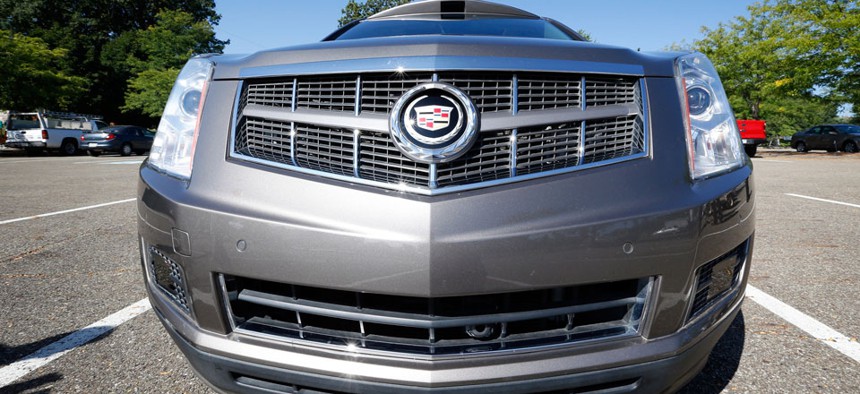The Biggest Hurdle for Self-Driving Cars: Congress

Infrared sensors and a low mounted camera can be seen below the bumper of this Cadillac SRX that was modified to be driverless by Carnegie Mellon University. Keith Srakocic/AP
Engineers are getting past the technical obstacles but lawmakers aren't updating the rules of the road.
Robot cars are coming.
Last year, Audi's auto-piloted concept car needed the spacious rear end of a station wagon to house its computer brain. This year's model uses hardware that's the size of an iPad and gets hidden behind a panel in the trunk.
Many components of self-driving are at or near commercial readiness—freeway control, traffic jam handling, and auto-parking among them.
But while engineers speed toward road-ready future cars, it's unclear that the rules of the road will be ready when the cars are. Politicians have made minimal progress in updating the legislation and regulations needed for the cars, which remain outdated and maddeningly inconsistent.
So what would Congress have to do to facilitate cars that could drive their passengers around?
"Clearly, in order for this technology to have broad potential, it would require some sort of uniformity [in regulation]," said BMW's Dave Buchko.
AUTOMAKERS: LET US TEST—AND TELL US HOW
But Congress doesn't appear to be in a hurry to give automakers those guidelines—or even get started on them.
"Autonomous cars and the future of autos is a topic that our members are interested in and working on, but right now it is still premature to discuss plans for regulation," said Charlotte Baker, a spokeswoman for House Energy and Commerce Chair Fred Upton.
At the moment, just four states and the District of Columbia allow any operation of driverless cars. The rules vary widely. In Nevada, for example, operators can use their cell phones while the car drives them around. Michigan, on the other hand, only allows manufacturer testing in very controlled circumstances for the time being.
Chris Attard, a Ford research engineer who works in Dearborn, Mich., acknowledges that the policy inconsistency could be a difficulty. "[Regulation] shapes how we approach the problems; it shapes what the final implementation will be and what we do with it," he said. "There has to be that handshake between government and private industry on this."
USER'S GUIDE TO TODAY'S ROBOT CAR
But for regulators and legislators to effectively craft guidelines, they have to understand what today's autonomous cars can and can't do.
Automakers shake their heads at the perception that robot-mobiles will soon allow you to nap in the backseat or watch a movie while the car navigates your daily commute. To a person, the car people say they're not about to rob you of the fun of driving—they just want to get rid of the boring parts. "We all love country roads," said Greg Stevens, who heads Ford's driver assistance and safety programs. "[But] there are aspects of driving that are not that much fun."
For instance, some cars are on the verge of being able to handle the bulk of a long road trip. "Freeway [driving] is pretty easy to accomplish," said Audi's Brad Stertz said. "Everybody's going the same direction, there's a little weaving, but you don't have cars backing out of driveways, or kids and dogs running across the street." Still, even in autonomous mode, the cars will require drivers to be alert and ready to take over at any time.
Already in Europe, some BMW drivers are taking advantage of Traffic Jam Assistant, which controls car speed and steering in some slow-driving situations. But thanks to a lack of U.S. policy, that feature is not available for American consumers.
Another advancement, announced last week by Ford, is a partnership with Stanford to help vehicles learn how to maneuver to increase their vision. Much like a driver would gradually steer toward the center line to see around a large truck, autonomous cars need to be in position to best make use of their sensors. "We want the vehicle to be aware and to do the kind of things that humans would do, which is to take a peek around this side, take a peek around that side, see what's up ahead," Stevens said.
Cars are also becoming more aware of their drivers. Buchko talks of cars that will be able to "intervene in emergency situations," pulling safely to the side and alerting emergency personnel if the driver passes out or has a heart attack.
Parking, too, could be mostly left to the car. "You pull up to a sporting event or work, and you've reserved a spot," Stertz said. "The car knows it and goes and parks itself [after it] drops you off at the front. That could be a huge thing at a Redskins game, right?"
WHAT NEXT?
Most of these advances are ready now or will be soon. Fully autonomous cars, capable of driving from destination to destination without human input, are still far off. How far off depends on whom you ask, but the technology has come a long way in a short period of time. "Three or four years ago, some of the stuff we're talking about today people would have considered as fairly far-fetched," Stevens said.
But for engineers to make tomorrow's cars a reality—and to make the most of the advances available today—they'll need some direction from Congress. "It requires the development of technology as well as the regulatory environment to make this stuff happen," Buchko said.
The real question, added Stertz, is not the technological aspect, but "what's going to happen in ... the federal government and in the states to open it up. Is there going to be consistency?" To be clear, automakers aren't rushing to join the "bash Congress" crowd. "It's not a case of blaming, because it's all new to everybody," Stertz went on. But for engineers to move forward effectively, they'll need "understanding [of] where the government is going to come down on what it will allow."



